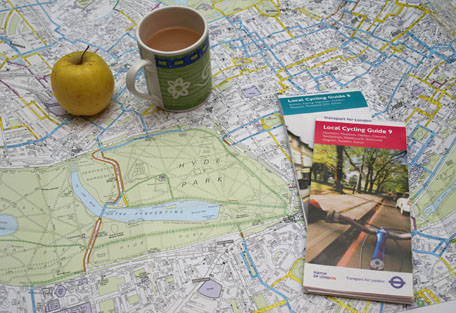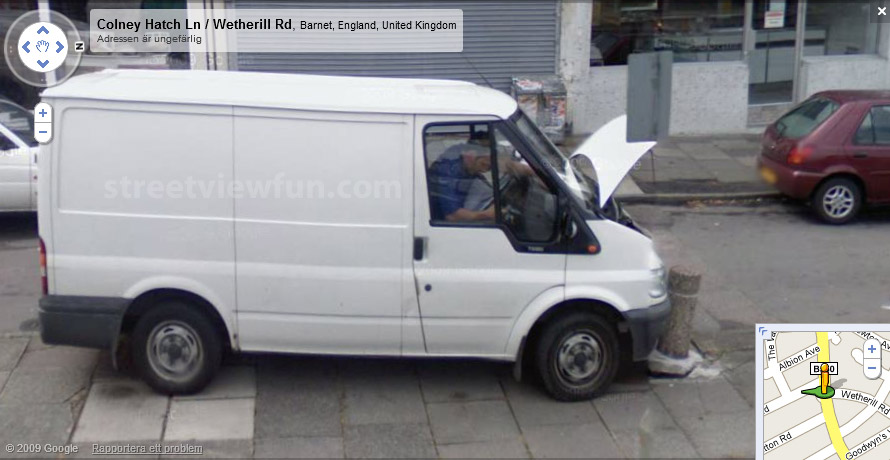This process can be summed up as follows:
1. Think in terms of a network.
Only by studying a cycle route network will it be possible to truly grasp the situation. (p.40, Cycling: the way ahead)
2. Plan the network.
Analyse journeys — origin/destination. (p.56, Cycling: the way ahead)
3. Study the feasibility of the network.
Studying the feasibility of a network is of a similar importance to setting up a cycling unit or appointing a cycling coordinator. (p.57, Cycling: the way ahead)
4. Introduce the network.
The level of minimum functioning is a prudent course to follow. (p.56, Cycling: the way ahead)
5. Develop the network.
Develop the network further on the basis of priority interventions and a timetable. (p.56, Cycling: the way ahead)
* * *
The bicycle is indeed a choice for the individual, but as the Get Britain Cycling report makes plain: "Too many people in the UK feel they don't have a choice."
If, then, a town or city is going to build on the initiatives and habits of its existing cyclists, it would be helpful to have an idea of who these people are. As I explained in my last blog, Google Street View shows a long, connected 'snapshot' of the cityscape at a particular moment. Typically this will be during the day, not least because it is important that the sun is high enough in the sky to ensure that shadows do not obscure buildings.
In terms of gauging what road conditions are like during the morning and evening rush hours, therefore, Google Street View is of no use. This means of course that commuting cyclists are not represented in the imagery that we see. Even so, it is illuminating to identify what sort of people do actually ride bikes during the day.
I have captured pictures of every "cyclist" I could find along the course of one particular route, in one particular town.
The above-shown route has been provisionally coded as 'O2'
We're starting in the west, and heading across town ...
| Bramford Road near junc. w/ Shafto Road |
| Bramford Road / Shafto Road |
| Bramford Road / Dandalan Close |
| Bramford Road / Windsor Road |
| Bramford Road / Yarmouth Road |
| Bramford Road / Gatacre Road |
| Bramford Road / Gatacre Road |
| Bramford Road / Prospect Road |
| Bramford Road / Bulwer Road |
| Norwich Road |
| St. Matthew's Street / Civic Drive |
| St. Matthew's Street / St. George's Street |
| St. Matthew's Street / St. George's Street |
| Crown Street |
| Crown Street |
| St. Margaret's Plain |
| St. Margaret's Green / St. Margaret's Street |
| St. Margaret's Street / St. Margaret's Green |
| Foxhall Road / Woodville Road |
| Foxhall Road near junc. w/ Camden Road |
| Foxhall Road / Dover Road |
| Heath Lane / Foxhall Road |
22 photographs in total, showing 20 people riding their bikes, and four people either standing with or walking with their bikes. Of the 24 people shown in the photos above, only one was adhering to Rule 59.
Of the 20 bike-riders, only four were female, and only one was a child under the age of ten. Of the 15 adult / adolescent males, three were riding on the pavement (including the elderly gentleman above). Instead of regarding these people as "heroes", however, the authorities are as likely to think these people should be punished with a fine.
* * *
I would like to take a moment to consider an extract from one of the five 'broad topic' recommendations contained within the Get Britain Cycling report:
Redesigning our roads, streets and communities
Too often cycle routes have been designed piecemeal or cyclists have been an afterthought in highway design. As we saw from some best practice areas, ‘thinking bike’ at the beginning of a design and planning process can reap dividends for other road users as well as cyclists.
Suitable road surfaces, arrangements at junctions, and interactions with other traffic are often about planning rather than cost. Cycle-friendly driving styles and the speed of passing vehicles can be supported by suitable design. Small improvements such as a well-placed bollard or junction redesign can make a big difference.
Purpose-designed exclusive rights of way, segregated from other traffic, are ideal, especially as part of a network of cycle paths and lanes, making use of verges, parallel rights of way, disused railways, bridal paths and similar. Continuity of funding would enable better and more cost effective planning of connected segregated routes.
Designated on-road lanes play an important role where segregation is not appropriate, and may require reallocation of road space. They need to be substantial - too often in the past they have been token gestures, ending abruptly at junctions, weaving across pavements, or just too narrow.
* * *
In a sentence, "The objective of good design is to create a safe and comfortable cycling experience for the entire end-to-end journey."
The question, surely, is how do we realise this objective?
If we take a moment to think about it, it is quickly apparent that there is only one practical way to set about the development of a safe and comfortable experience for the entire end-to-end journey, and that is to pursue a global or holistic approach. We can't keep doing things piecemeal. That doesn't work. Cycling needs connectivity and it needs density, and this can only be provided for during the planning phase. (A safe and comfortable cycling experience, by contrast, can only be provided for during the development phase, so let there be no debate about what comes first.)
In addition, as I report in this blog, "Mobility is not just about getting from A to B, but also about knowing how to get from A to B." Cyclists therefore need to be aware of, and to be able to make use of, an information set for optimising their journey.
In Holland, direction signs at strategic locations (such as at junctions) enable people to find their way without having to refer to a map. The video below, produced by Mark Wagenbuur of Bicycle Dutch, explains how these signs work in the city of 's-Hertogenbosch.
In the UK, where the provision of quality infrastructure for cyclists is incomplete, there's a tendency to publish maps which show what conditions are like on the ground, so that if you did want a traffic-free route, you had the opportunity to plan one.
 |
| Image from rashbre central |
* * *
The photos below are all of the same road: Friars Stile Road in Richmond.
| This section of road is coded in blue in the London Cycle Guides. |
| This section of road is coded in yellow in the London Cycle Guides. |
| This section of road is not coded at all in the London Cycle Guides. |
That's three photos of the same road, each of which is marked differently on the map.
* * *
Another way to code routes in the built-up area is to assign one colour per route. The main problem with doing it this way is that there are only so many individual colours to choose from. If you have a network of fifteen-plus routes, one colour per route is pretty much a non-starter.
It is an established fact that colour-coded routes make journey-planning easier, and this is why I believe that compass colours represent a real breakthrough in terms of pursuing a 'network first' approach. In those towns and cities which have a certain density and a certain shape, I am confident that I would be able to code most networks. I would like to show you how I set about doing this in the case of Ipswich.
 |
| Ipswich and surrounding area |
As you can see, Ipswich is bordered on three sides by major roads. The town itself has a wagon-wheel shape, which I like, although the rather large river which runs up from the south gives it the appearance of a cake with a slice taken out.
The first thing I did was to transfer all the route information shown in the Ipswich Cycle Route map [pdf] onto Google maps. I coded all the routes in the same colour because it didn't make any difference to me what the conditions were like on the ground - I just wanted to know where the officially-approved cycle routes went. I made a mental note of those routes on which you are supposed to walk your bike.
If you are interested to see what it looked like, please click here.
The next thing I did was to lay some compass colours over the top. It sure didn't look pretty, but it gave me a starting point. You can see the first draft by clicking here.
Then I started laying down the routes on a clean map, and just kept reworking it so that more and more of the officially-approved routes were included, and more and more of the routes were presented in such a way as to show self-consistency.
Then I started laying down the routes on a clean map, and just kept reworking it so that more and more of the officially-approved routes were included, and more and more of the routes were presented in such a way as to show self-consistency.
Red-coloured routes
Navy blue-coloured routes
Red and navy blue-coloured routes. These 'bold' colours give the map its basic identity.
Green-coloured routes
Orange-coloured routes
Cyan-coloured routes
Circular route
Finally, once I was reasonably happy with the way the routes had been laid down, I copied them onto the original template, as can be seen here. This gave me the opportunity to see what was missing.
You can probably see that a green-coloured route could be installed going from Brazier's Wood (near the Orwell Bridge) up to Kesgrave. If the authorities liked the look of this they would do well to take note of this advice from Cycling: the way ahead: "All the installation measures which call for little planning may be applied without major risk of error or loss [...] Given their low cost, the small amount of extra work which they entail and the possibilities of corrections in the case of error, such measures may be adopted automatically."
Warren Buffett says, "I don't look to jump over 7-foot bars. I look around for 1-foot bars that I can step over." The case is, as Cycling: the way ahead explains, "The network can be introduced on the basis of an overall plan (preliminary plan)." In the first year or so, we simply do not need to make it any more complicated than that.
View Ipswich Cycling Network (proposed) in a larger map
[Update: There were some routes missing. You can see on the map above that I have replaced the route C122 - Cyan1 to Cyan2 - with a dark green-coloured route. Whether this has made it better or worse is not for me to say. But do please bear in mind that the map you are looking at could easily fit onto the back of a post-card.]
Mark Ames over at i b i k e l o n d o n recently concluded one of his blogs by leaving the last word to cycling's ambassador of common sense, Chris Boardman. If you want to read the quote in full, please click here. "The key is local governments having a clear and detailed holistic view of what they want their cities to look like in 10 years."


